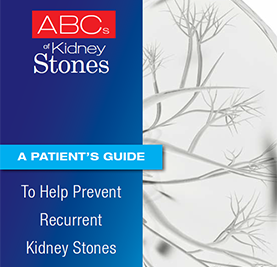- Home
- Preventing Kidney Stones
- Magnesium
Magnesium
Dietary guidelines for magnesium
Maintain high magnesium intake


Magnesium plays an important role in managing kidney stone risks because it helps to reduce the amount of oxalate excreted in the urine. It may also help prevent oxalate from binding with calcium in the urine, a process that can lead to the formation of calcium oxalate or calcium phosphate stones.
According to the Dietary Reference Intakes (DRIs), adult women should consume 320 to 360 mg/day of magnesium. Adult men should consume 400 to 420 mg/day. For information on the magnesium content of specific foods and brands, visit the USDA Nutrient Data Laboratory Web site: http://www.nal.usda.gov/fnic/ foodcomp/search/ or http://www.ars.usda.gov/Services/docs.htm?docid=20958.| MAGNESIUM-RICH FOODS1 | ||
|---|---|---|
| FOOD ITEM | SERVING SIZE | MAGNESIUM CONTENT (mg/serving) |
| Peanuts, all types, roasted | 1/2 cup | 131 |
| Tofu, raw, regular | 1/2 cup | 127 |
| Peanuts, all types, raw | 1/2 cup | 123 |
| Broccoli, cooked | 2 large stalks | 120 |
| Spinach, cooked | 1/2 cup | 79 |
| Chard, Swiss, cooked | 1/2 cup | 76 |
| Soybeans, cooked | 1/2 cup | 74 |
| Tomato paste, canned | 1/2 cup | 67 |
| Simulated meat products, meat extender | 1 ounce | 61 |
| Small white beans, cooked | 1/2 cup | 61 |
| Sweet potato, canned, mashed | 1/2 cup | 61 |
| Black beans, cooked | 1/2 cup | 60 |
| Dock (sorrel), cooked | 1/2 cup | 60 |
| Nuts & seeds, all types | 1 ounce | 60 avg (9-152) |
| Pumpkin seeds | 1 ounce | 152 |
| Chestnuts | 1 ounce | 9 |
| Chili with beans, canned | 1/2 cup | 58 |
| White beans, cooked | 1/2 cup | 57 |
| Baked beans | 1/2 cup | 55 |
| Navy beans, cooked | 1/2 cup | 53 |
| Peanut butter | 2 tablespoons | 51 |
| Succotash, cooked | 1/2 cup | 51 |
- Bradley L, et al. General guidelines in medical management. In: Resnick MI, Pak CYC, eds. Urolithiasis: A Medical and Surgical Reference. Philadelphia, PA; WD Saunders and Company; 2009:chap 11.
This information is intended to augment, not replace, the advice of your doctor. If you have any questions about this content, please talk to your doctor.


